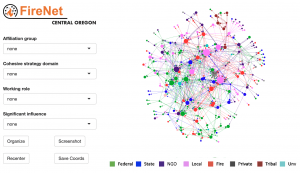Pilot surveys to map wildfire risk management networks were previously administered in North Central Washington and the Wasatch Region of Utah. Survey results were used to calibrate a new management network survey for Central Oregon, which was administered in 2021. Over 10 rounds, 230 individuals in the wildfire risk management network were identified, representing 50+ affiliations. These survey data were used to develop a detailed social map of the network’s working relationships, shown below. Our findings from this survey are presented in Co-Managing Wildfire Risk in Central Oregon.
Network representations and interactive tools such as this website of the Central Oregon wildfire management network allow users to explore the network’s qualities and underlying structure, including the relationships among different affiliation groups, Cohesive Strategy domains, working roles, and degrees of influence. The network diagram is constructed from digital “springs” that pull on connected nodes so that the tensions pull closer together those nodes (people) that are interconnected, with the result that nodes with more connections (relationships) are drawn toward the center of the diagram. In the main window, you can tug on individual nodes to see their connections. Then press the “Organize” button to return the network to a steady state.
Our Central Oregon network survey and findings are being vetted through the Stakeholder Advisory Council to develop their interpretations of the network’s structure, the roles of different individuals, and how influence is propagated through the network.
For each of the three study areas, we are continuing to explore network structure and function by examining areas where working relationships are particularly dense, where social gaps may limit opportunities for coordination, and the specific individuals and organizations that link multiple sectors of the network. These understandings are being used to revise theoretical and abstract concepts such as network motifs to build our SNIP social network model for simulation modeling.
